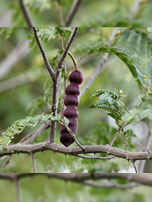Shikakai

Botanical Name : Acacia concinna (Willd.) DC.
Family : Mimosaceae
Names in different Indian languages :
English : Soap nut acacia
Hindi : Satala
Kannada : Sege
Malayalam : chaemalanta
Sanskrit : Saptala
Tamil : Shikaakaai
Telugu : Shikaya
Unani : Shikaakaai, Kharunb Nabti.
Synonyms :
Saptalaa, Shitalaa,
Saatalaa, Shrivalli, Kantvalli
A. sinuata (Lour.) Merrill;
A. rugata (Lamk.) Ham.
Morphology :
Acacia concinna has been used traditionally for hair care in the Indian Subcontinent since ancient times. It is one of the Ayurvedic medicinal plants. The fruit is known in India as shikakai (Hindi: शिकाकाई, śikākāī; Kannada: ಸಿಗೆಕಾಯಿ; Tamil: சிகைக்காய் – literally “hair-fruit”, sigai=tresses and kaay=fruit;) “fruit for hair” in its use as a traditional shampoo. In order to prepare it the fruit pods, leaves and bark of the plant are dried, ground into a powder, then made into a paste. While this traditional shampoo does not produce the normal amount of lather that a sulfate-containing shampoo would, it is considered a good cleanser. It is mild, having a naturally low pH, and doesn’t strip hair of natural oils. Usually no conditioner is needed, for shikakai also acts as a detangler. An infusion of the leaves has been used in anti-dandruff preparations.
A. concinna extracts are used in natural shampoos or hair powders and the tree is now grown commercially in India and Far East Asia.[7] The plant parts used for the dry powder or the extract are the bark, leaves or pods. The bark contains high levels of saponins, which are foaming agents found in several other plant species used as shampoos or soaps. Saponin-containing plants have a long history of use as mild cleaning agents. Saponins from the plant’s pods have been traditionally used as a detergent, and in Bengal for poisoning fish; they are documented to be potent marine toxins
Uses :
Febrifuge, expectorant, emetic, spasmolytic, diuretic, antidiarrhoeal